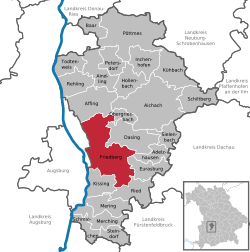Friedberg, Germany
| Friedberg | ||
|---|---|---|

Town hall
|
||
|
||
| Coordinates: 48°21′N 10°59′E / 48.350°N 10.983°ECoordinates: 48°21′N 10°59′E / 48.350°N 10.983°E | ||
| Country | Germany | |
| State | Bavaria | |
| Admin. region | Schwaben | |
| District | Aichach-Friedberg | |
| Government | ||
| • Mayor | Peter Bergmair (SPD/"Parteifreie Bürger") | |
| Area | ||
| • Total | 81.20 km2 (31.35 sq mi) | |
| Elevation | 514 m (1,686 ft) | |
| Population (2015-12-31) | ||
| • Total | 29,339 | |
| • Density | 360/km2 (940/sq mi) | |
| Time zone | CET/CEST (UTC+1/+2) | |
| Postal codes | 86316 | |
| Dialling codes | 0821 | |
| Vehicle registration | AIC, FDB | |
| Website | www.friedberg.de | |
Friedberg is a city in the district Aichach-Friedberg, Bavaria, Germany, with some 30,000 inhabitants. It is located next to Augsburg at the Lech river. The city was founded in the 13th century in order to collect a toll from people using the bridge across the Lech River.
The city lies almost entirely on the western edge of the hills along the Lechleite, where the river Lech has formed a wide bed from glacial melt water.
Settlements in the area of Friedberg can be traced to Roman times through archeological findings of pottery and brickworks in the Hügelshart, Rohrbach (dating from the last third of the 3rd Century AD), Stätzling (late 3rd Century to 4th Century AD) and Wulfertshausen districts.
The town is mentioned in historical documents for the first time in letter of protection from Conrad of the House of Hohenstaufen together with Duke Ludwig II, also called "the Strict", of Bavaria and the Burgher of Augsburg, in 1264. The Fridberch castle was subsequently built to serve as a border security and customs post for the Duchy of Bavaria, but put the town in opposition to the free city of Augsburg. The castle was the cause of the first burning of Friedberg by Augsburg in 1396. The town was subject to the many frequent wars between Swabia, Bavaria and Augsburg.
In 1485 Balthasar Hubmaier, a leading figure of the Baptist Reformation, was born in the town.
A revival in the town's fortunes came when, in 1568, the Duchess Christine chose Friedberg castle as her seat following her husband's death. The town became the centre of Bavarian court life, but was short lived when the town was ravaged by the plague in 1599. More suffering came as the town was sacked twice by the Swedes during the Thirty Years War. After the war only the town hall, castle and city walls were left standing. The town was soon flourishing again as the Dukes of Bavaria encouraged artisans to settle in the area with the establishment of guilds in neighbouring Augsburg. Due to overcrowding, Friedberg offered accommodation to those displaced artisans who could not find rooms in Augsburg, and were not yet Master Craftsmen.
The Pilgrimage church of "Our Lord's Rest", the Herrgottsruh, was built in 1753, is considered one of the most beautiful churches of the Bavarian rococo.
...
Wikipedia



